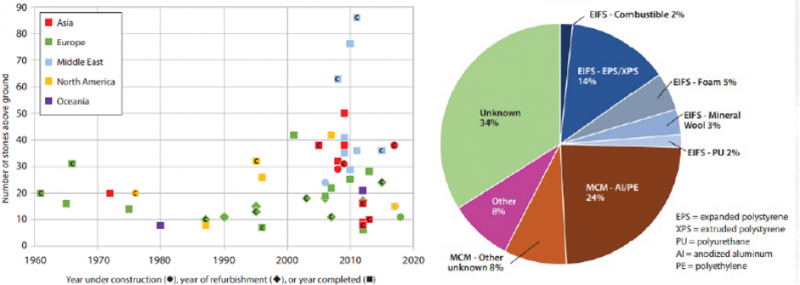As Façade Fire occurs more frequently, what can we do to manage it? An opinion piece by Fahri Ali Imran.
Over the last 10 years, it can be seen that Façade Fire occurred more frequently, and at an alarmingly high rate, on a global scale. This is backed up by recent (separate) researches, by Spearpoint, et. al. (OFR Consultant) and Bonner & Rein, et. al. (Imperial College London), with both researches suggesting an exponential rate of façade fire.

Façade Fire Trend from 1990 – 2018 by Spearpoint et al. Notice the majority of the façade fire incidents involved some sort of polymer material (EPS, XPS, PE), which may be combustible.
Spearpoint et. al. suggested that one of the major reasons is the increasing usage (or some percentage of use) of combustible material as the Core Material of a Sandwich Panel or Metal Composite Panel. The widespread usage of Composite Panel or Sandwich Panel with polymer core itself increases within the last 10 year, with some aspect of insulation, for ‘green’ building and energy saving aspect, as well as its relatively cheaper price to those with non-combustible core. Within their research, there seemed to be some cases where façade fire occurred at refurbished buildings, at which they utilized Composite Panel with combustible polymer core as its façade.
Perhaps, the most infamous Façade Fire within the last 10 years was the Grenfell Tower Fire. Given the magnitude of Grenfell Tower Fire, which caused total loss of the building, and took the life of 72 people, in my opinion it is time to re-evaluate and to ask the basic question: what went wrong and what can we do to manage the risk?
First, let’s talk about the elephant in the room. There are various standardized testing methods for Composite Panel with combustible core. One could be more detailed than the others. There are tests which accounts for how the rig is setup, the combustible droplet (usually aluminum droplet), fire spread rating, etc. Aside from the various testing method, it is also important to note that some countries do not have its own testing method, or had not appointed which standard to use. This includes Indonesia, which, to the best of my knowledge, do not have its own standardized testing method specifically for MCM / Composite Panel Façade, nor does it appoint which international standard to use. This led to ‘grey area’ where contractors can suit to their own benefits, usually cost constraint one.
So government intervention is likely needed. Australia had taken the direct approach to survey all buildings (within a certain height and occupancy use) that utilizes composite panel materials, and to retrofit them if necessary. Malaysia recently prohibited the use of these panels for buildings more than a certain height criterion. It would be ideal for our government to also interfere, either through standardization or retrofitting action.
What else can we do?
Without neglecting he fact that this issue needs to be handled from top level (government) down, there are some aspects that we can implement to reduce the risk of façade fire.
As per research by Kothoff et. al., there are 3 basic scenario for a façade fire: 1. Fire spreading from an adjacent building, 2. Fire starting from outside of the building, 3. Fire starting from inside of the building. Both Kothoff et. al., and Spearpoint et. al. concluded that the most common scenario is Scenario 3, where the fire actually started from the inside of a compartment.
Therefore, it is important for us to implement the Layers of Fire Protection, throughout the whole building. This concept is based upon the 7 Layers of Fire Safety in Buildings by The Confederation of Fire Protection Associations Europe. As façade fire occurred most frequently from a compartment fire, we need to make sure that all 7 layers of protections are available. Prevention is key, and Fire Risk Assessment is needed to address all fire risks associated with the building. Detection needs to be reliable and connected to water-based fire protection system i.e. sprinkler system; for Early Suppression. Evacuation System needs to be accounted for during the Fire Risk Assessment, to make sure all occupants can evacuate safely even in the worst-case scenario. Compartmentation is also important, making sure the fire to be contained within the compartment. This would need consideration for fire rated structure and passive fire protection, including Cavity Barrier and Firestop material. The last 2 layers of protection: Structural Safety and Fire Fighting Intervention can prevent a total loss from occurring.
Writer: Fahri Ali Imran - CEO Ignis Fire & Risk

0 Comments